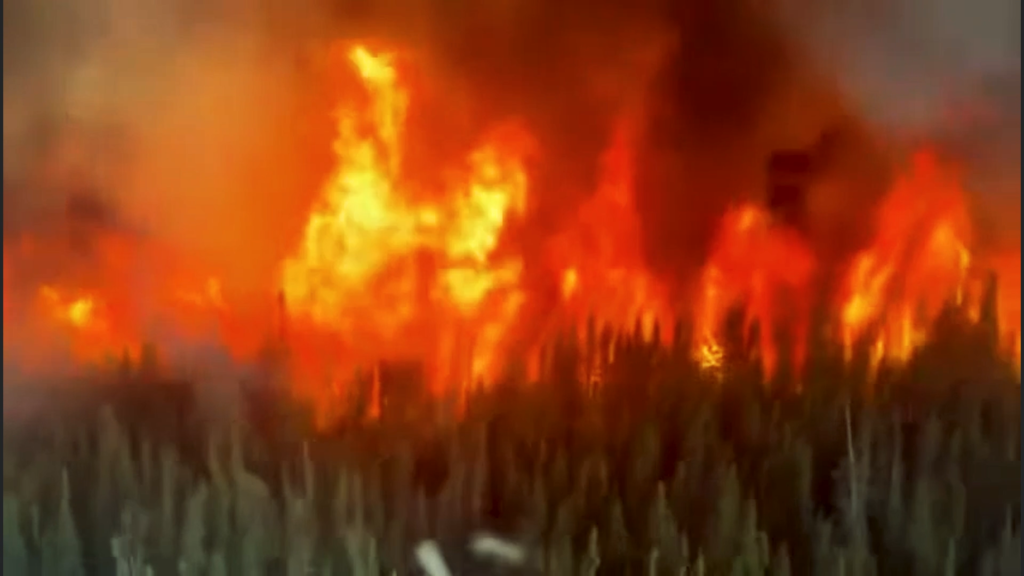Wildfires Force Mass Evacuations from Northwestern Ontario First Nations as Threat Intensifies

Thunder Bay, The Gulf Observer: As raging wildfires continue to threaten remote First Nations communities in northwestern Ontario, hundreds of residents have been forced to evacuate amid growing concerns over safety and air quality. The most immediate threat stems from Red Lake 40, a wildfire currently spanning over 11,000 hectares.
Phillip Campbell, elder and head councillor of the North Spirit Lake First Nation, was among approximately 240 evacuees who boarded the first flight out of the isolated Oji-Cree community on Friday afternoon. The plane landed in Thunder Bay, where evacuees — many of them medically vulnerable — are being transported further to Toronto for shelter.
“If it’s windy from there, the fire will go to North Spirit really fast and that’s dangerous,” Campbell warned, expressing concern for those still awaiting evacuation. Fewer than 500 people live in North Spirit Lake, situated in Treaty 5 territory.
South of the community, Pikangikum First Nation, one of the region’s largest remote settlements, is also preparing to evacuate beginning Saturday. With Red Lake 62 — an out-of-control blaze exceeding 26,000 hectares — encroaching on the area, around 2,000 evacuees from this Ojibway community are scheduled for relocation to Toronto and Mississauga.
Ben Curtis, Inspector of Operational Support for the Ontario Provincial Police in the northwest region, confirmed that emergency teams are compiling evacuation lists in coordination with local leadership. “We’re prioritizing vulnerable individuals — those with mobility challenges or medical concerns — for the first wave of evacuations,” he said.
Meanwhile, MacDowell Lake, a much smaller community of under 100 residents, has also issued an evacuation alert.
As of Friday, nearly 50 wildfires are burning across northwestern Ontario at various levels of containment. Red Lake 12, the largest blaze, has scorched over 195,000 hectares, setting a provincial record.
Alison Bezubiak, a fire information officer, noted that prolonged drought conditions, low humidity, and lack of rainfall are driving “extreme fire behaviour.” While rain is forecasted over the weekend, the extent of its impact remains uncertain.
The Ontario government, through the Office of Minister of Emergency Preparedness and Response Jill Dunlop, stated:
“Our government is working closely with local communities, First Nations leadership, and emergency partners to coordinate safe evacuations and support vulnerable residents. We remain in close contact with provincial and federal counterparts to ensure evacuees receive appropriate care, transportation, and support.”
Still, many evacuees are grappling with the emotional toll of leaving their homes. “It’s difficult when you travel from home,” said Homer Meekis, a North Spirit Lake band councillor who arrived in Thunder Bay with his children and grandchildren. “Staying in a hotel with family is going to be really crowded. People are used to their own places.”
Evacuee Edna Rae-Harper, aunt of Chief Brandon Rae, explained that the community had previously prepared for evacuation a month ago before conditions temporarily improved. “I just wanted to stay home, but nobody can stay home because everybody has to go,” she said.
While six evacuation flights were expected to depart for Thunder Bay on Friday and Saturday, other communities have seen disruptions. Sandy Lake First Nation — which had begun repatriating some of its 2,000 evacuees last week — has had to pause return flights due to demand for aircraft elsewhere. Some flights from Barrie and Peterborough have also been suspended.
Air quality warnings remain in effect throughout much of the region, with particularly high fire hazards persisting in the Red Lake and Nipigon fire management sectors.
Ontario’s Ministry of Natural Resources and Forestry says crews are working around the clock.
“Wildland fire management staff are actively engaged in aerial suppression, ground operations, and structural protection efforts,” said ministry spokesperson Mary Votsis. “Our FireRangers, backed by specialized aircraft and advanced technology, are among the best in the world.”
As the situation evolves, authorities and communities continue to hope for relief from forecasted rainfall and remain vigilant against the volatile threat posed by the ongoing wildfires.


